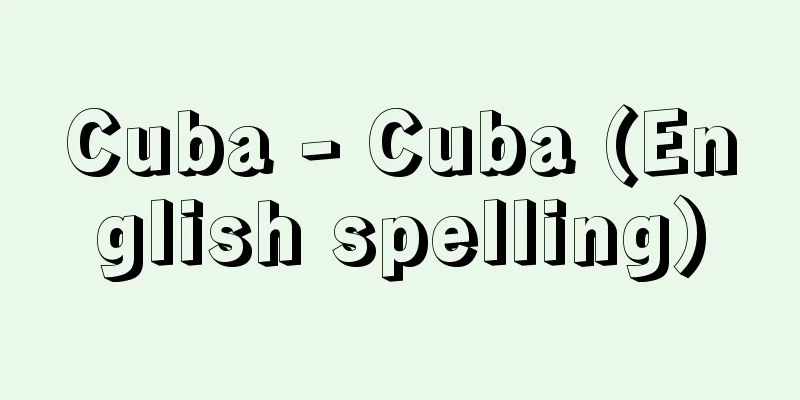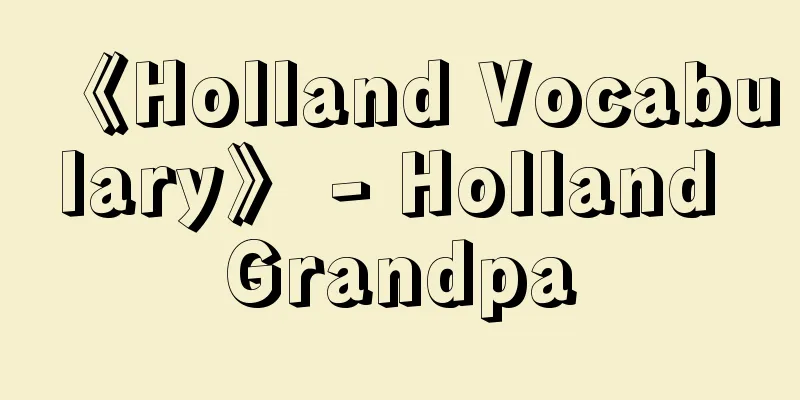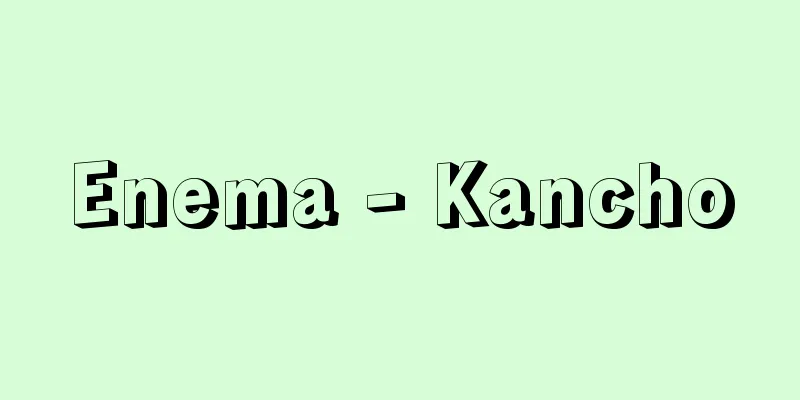Cuba - Cuba (English spelling)

|
Cuba is a country that consists of Cuba, the largest island in the West Indies, and a group of about 1,500 coral reef islands surrounding it. Its official name is the Republic of Cuba (República de Cuba). Its land area is 110,861 square kilometers, roughly the size of Hokkaido, Akita and Iwate prefectures combined, and it has a population of 11.24 million (2006 estimate) and 11.25 million (2010 estimate). Its capital is Havana, with a population of 2.15 million (2008 estimate). Since declaring itself a socialist state in 1961, it has also been called the "red island in the Caribbean," and as of 2012 it has maintained that system. [Kunimoto Iyo] NatureCuba is a long, narrow island with a generally flat land, 70-200 km wide from north to south and 1,263 km long (total length), with a coastline rich in inlets and surrounded by coral reefs. It is separated from the US Florida Peninsula by the 300 km wide Florida Straits in the northeast by the Bahamas, from Hispaniola (where Haiti and the Dominican Republic are located) by the Windward Channel in the east, from Jamaica by the Cayman Channel in the southeast, and from Mexico's Yucatan Peninsula by the Yucatan Channel, through which the Gulf Stream flows, on its western coast. Cuba was once part of a limestone plateau that extended from the Yucatan Peninsula to the Florida Peninsula, but erosion has progressed and three-quarters of the country's land area is flat land with an elevation of less than 100 meters and gentle slopes. The mountain range, which occupies a quarter of the country's land area, is made up of three different mountain ranges, from east to west: Oriental (Eastern Mountain Range), Central (Central Mountain Range), and Occidental (Western Mountain Range). The Eastern Mountain Range is made up of the Sierra Maestra and other mountain ranges, and is home to the country's highest peak, Mount Turquino (2,005 meters). The northern slope is gentle, and the central lowland of the Kaut River basin, which spreads between the mountain ranges on the northern coast of the island, is the main agricultural region. The Sierra Maestra belongs to the Pacific Ring of Fire orogenic belt and is an area prone to earthquakes, but the southern bank of the steep slopes is home to natural harbors consisting of the drowned valleys of Santiago de Cuba and Guantanamo. The Central Mountain Range is made up of low-altitude mountain ranges centered around the Tri-Dado Mountain Range. The Western Mountain Range is mainly made up of the Sierra de Organos and Rosario Mountains. This mountain range is composed of limestone and has a prominent karst topography. The name of the Sierra de Organos comes from the resemblance of the hills left after erosion to a pipe organ. The rivers are mostly small, typical of the limestone plateau. The longest river is the Kaut River (250 km), which originates in the Sierra Maestra and flows into Guacanayabo Bay on the east coast. Cuba is located between the 20th parallel and the Tropic of Cancer, and has a tropical climate with an average temperature of 27.1°C in August and 21.6°C in January, the lowest average temperature, which is relatively bearable due to the influence of trade winds. The average annual precipitation is 2000 mm in the northwest, and 1000-1500 mm in the rest of the country, with Guantanamo, in the shadow of the Sierra Maestra mountain range, receiving the least amount. The rainy season is from May to October, and hurricanes hit the island from May to November, coinciding with the rainy season, and the northwestern region in particular often suffers heavy damage. [Kunimoto Iyo] historyBefore Columbus arrived in the West Indies, the indigenous Taino and Siboney people lived on the island of Cuba. The population size is estimated at about 300,000. However, when the Spanish began colonization, the indigenous population rapidly decreased due to harsh forced labor and unprecedented diseases brought by the Spanish. 100 years later, by the end of the 16th century, these indigenous people had almost become extinct, and black slaves were brought in from Africa as a labor force. Throughout the colonial period, Havana played an important role as a stopover port on the trade route connecting Spain with the Americas, but the development of the island itself, which had no precious metal resources, progressed very little, and it was not until the 19th century that Cuba rapidly developed into a major sugar-producing area. In the early 19th century, independence movements broke out in various Spanish colonies, and while they gained independence one after the other, Cuba remained under Spanish rule until the end of the 19th century. The Cuban criollos (white people of Spanish descent born in the colonies) felt threatened by the independence of the French colony of Saint-Domingue (present-day Haiti) in the western part of Hispaniola, located to the east, as a black nation in 1804, and did not rise up in the independence movement; Spain, which had lost its colonies one after another in the Americas, strictly controlled and ruled Cuba as its last stronghold; and Saint-Domingue, an important sugar-producing region, had its sugar production base destroyed by independence, so the island of Cuba suddenly grew to replace Saint-Domingue as a sugar-producing region, which was a factor in delaying Cuba's independence. Demanding equal status and freedom with the Spaniards who had immigrated from their home country, the Creoles launched the First War of Independence in 1864, which lasted for 10 years, but were defeated. In 1895, a new independence movement, known as the Second Independence Movement, was launched, and with Spain's defeat in the Spanish-American War in 1898, Cuba achieved independence from Spain in 1902 under the protection of the United States. However, this independence was only as an American protectorate, as the right of American political and military intervention was inserted into the constitution (the Platt Amendment). American capital had already been present in Cuba in the mid-19th century, but after independence, American capital's advance into Cuba extended into all sectors, dominating the Cuban economy. With the investment of huge amounts of American capital, railroads and roads were built, and the sugar cane-producing areas, which were the core of the Cuban economy, expanded from the area around Havana in the early 20th century to the center of the island, and further to the southeastern mountainous region, creating a sugar monoculture economy and an economic structure dependent on the American market. At the same time, a small number of oligarchy connected to American capital monopolized wealth, creating a society with a large gap between the rich and the poor. The dictatorship of General Fulgencio Batista, who emerged during the chaotic period of the Great Depression in the 1930s and became the key to the US control of Cuba, eventually gave birth to the fierce anti-government movement and guerrilla activities of Fidel Castro in the 1950s. The guerrilla forces led by Castro, supported by a wide range of resistance movements by the people, succeeded in overthrowing the Batista dictatorship on January 1, 1959 (Cuban Revolution). The new government adopted the Socialist Manifesto in 1961. After that, Cuba worked on reforms under a socialist system and strengthened its ties with the Soviet Union and socialist countries of Eastern Europe. During this period, in 1962, the construction of a Soviet missile base in the country was allowed, and the conflict between the US and the Soviet Union escalated to the brink of nuclear war, leading to the Cuban Missile Crisis (Cuban Missile Crisis). After that, with the collapse of the socialist systems of Eastern European countries in 1989 and the dissolution of the Soviet Union in 1991, the Cuban economy, which relied on these former socialist countries for 85% of its trade, fell into a severe economic depression. However, while maintaining a socialist system, since the mid-1990s economic liberalization policies have allowed foreign capital to be introduced into some economic activities, and private enterprises and individual farming have been permitted. In February 2008, Fidel Castro stepped down as President of the Council of State, and his brother Raul Castro became chairman, which has led to a major shift from the "principle of egalitarianism" that Fidel Castro led the revolution to "improving productivity and quality of life." At the Communist Party Congress in April 2011, Fidel Castro resigned as First Secretary of the Communist Party, and Raul Castro was named his successor. Economic reforms were put forward that incorporated a merit-based system and a partially market-oriented economy, with the aim of rebuilding the economy by reducing the inefficient state sector and expanding private enterprise. [Kunimoto Iyo] Politics and DiplomacyThe current Constitution was promulgated in 1976 (amended in 1992). Legislative power is vested in the National Assembly of People's Power, which is composed of deputies (614 members) elected by direct voters. The term of office is five years, with regular sessions held twice a year. Voters must be 16 years or older to vote, and 18 years or older to be elected. The National Assembly of People's Power elects 31 members of the State Council from among its deputies. The three powers of the legislative, executive, and judicial branches are separate, and the State Council is the highest state organ that coordinates and guides these three powers. Its chairman is the supreme leader who also serves as Head of State, Head of Government, and Commander-in-Chief of the Armed Forces. Executive power is vested in the Council of Ministers, which is nominated by the National Assembly of People's Power and appointed by the Head of State. Its members are the chairman, the first vice-chairman, several vice-chairmen, the chairmen of each State committee, and the ministers of each ministry. Judicial power is exercised by the Supreme People's Court and other courts as provided for by law. The local government system is made up of People's Power Administrative District Councils, composed of delegates elected by direct vote from the 169 administrative districts (municipio), which are equivalent to Japanese cities, towns and villages, and People's Power Provincial Councils, elected by delegates from the 14 provinces (provincia). Their terms of office are two and a half and five years, respectively. The only political party is the Communist Party of Cuba, which exercises full leadership in Cuban society and the state. The basic tone of Cuba's foreign policy is peaceful coexistence with all countries and non-interference in their internal affairs, but after the Cuban Missile Crisis, its relationship with the United States rapidly deteriorated, and from the 1960s to the 1980s, Cuba strengthened its ties with socialist countries. In particular, Cuba strengthened its ties with the Soviet Union, and received increased economic and military assistance from the Soviet Union. However, Cuba suffered a major economic blow with the collapse of the socialist systems of Eastern Europe and the Soviet Union. As for its relations with Latin American countries, Cuba was expelled from the Organization of American States at the Foreign Ministers' Conference held in Punta del Este, Uruguay in 1962, and after the decision to strengthen the economic blockade of Cuba at the same conference in 1964, diplomatic relations with all Latin American countries were severed, except for Mexico. However, diplomatic relations with Latin American countries were restored in the 1970s, and in August 1975, the Organization of American States decided to normalize relations with Cuba. Relations with the United States deteriorated again with the signing of an Anti-Hijacking Agreement in February 1973, indicating that government-to-government talks were possible, but the participation of Cuban forces in the Angolan War in 1975 and the Ethiopian-Somali War in 1977. The promulgation of the US Immigration Restriction Act in 1980 led to the defection of approximately 125,000 Cubans to the United States, further worsening relations between the two countries. The US economic blockade remains in place as of February 2012. However, under the Obama administration, the United States eased some of the sanctions against Cuba, significantly loosening restrictions on travel to Cuba and dollar remittances by Cuban citizens in the United States. Raul Castro, who took over as President of the Council of State from Fidel Castro in February 2008, visited Russia, which had been estranged from him since the collapse of the Soviet Union, for the first time in 22 years in 2009, and strengthened relations with China, which was trying to penetrate Latin American countries, and obtained huge economic aid from both countries. He also normalized relations with the European Union (EU), which had continued to impose economic sanctions against Cuba. Furthermore, he is building close ties with countries with anti-American leftist governments that have emerged in Latin America, such as Venezuela. [Naoko Kurihara and Iyo Kunimoto] Economy and IndustryThe sugar-dependent monoculture economic structure that characterized the Cuban economy from the 19th century to the 1980s has changed significantly since the mid-1990s, following the collapse of the socialist systems of the Soviet Union and Eastern Europe. Under the socialist planned economy after the revolution, the country attempted to move away from the sugar monoculture and promote industrialization (First Five-Year Plan), but the rapid industrialization policy caused economic turmoil, and in the Second Five-Year Plan that began in 1967, a policy was once again adopted that emphasized sugar, with sugar accounting for 70-80% of exports. During the time when the former Soviet Union was the hegemonic power, the Soviet Union purchased Cuban sugar at a higher price than the international price under a long-term trade agreement and economic cooperation agreement, and at the same time sold crude oil to Cuba at a lower price than the international price. In addition, the Soviet Union continued to provide huge economic aid to Cuba for 30 years. At the same time, the economic blockade by the United States, which continues as of February 2012, has cut Cuba off from the nearest large market. The Cuban economy, which had been extremely dependent on the Soviet Union and Eastern European countries, was dealt a devastating blow by the collapse of the socialist systems of the Soviet Union and Eastern European countries, and shortages of goods caused the lives of the people to collapse. However, new economic reforms introduced after 1993 have lifted the ban on citizens possessing foreign currency, allowed some self-employment, introduced a cooperative system based on an independent accounting system, and permitted the development of tourism resources with foreign capital, and the structure of the Cuban economy is steadily changing, even while clearly stating that it will maintain its socialist system. In recent years, the tourism industry, developed through foreign investment, has come to occupy an important position, and in the 21st century, nickel and other mineral resources have become important exports, replacing sugar. Nickel, one of the world's largest deposits of which has been confirmed, is a secondary product of laterite iron ore and is extracted from mines near Moa Bay in the northeast. The dramatic transformation of Cuba's economy is clearly shown in the change in the composition of exports by trade commodity. Sugar, which accounted for over 70% of total exports until the 1980s, fell to the 50% range in the 1990s, 31% in 2000, and only 7% in 2005 statistics. Meanwhile, exports of mineral resources, which began to grow in the late 1990s, have increased significantly since the beginning of the 21st century, and in 2010 statistics it was ranked first at 54.9%, far surpassing agricultural products (20.0%), which came in second. Industrial products and petroleum account for almost half of the total imports, and food imports are also high depending on the year. In terms of import partners by country, the EU (21.8%) and China (13.4%) are at the top, while Venezuela (12.8%) and the EU (9.8%) are at the top of the export destinations, so Cuba is not overly dependent on any particular country (2010). This is a major change from the former Soviet Union, which accounted for around 60% of both exports and imports before the collapse of the socialist system. [Kunimoto Iyo] Society and CultureAbout 60% of the population is mulato (a mix of Spanish white and black), about 25% is Spanish white, about 15% is black, and there is a small number of mestizos (a mix of white and indigenous people). The official language is Spanish. Education, which the government focused on most during the revolution, has achieved great results, and efforts have been made to eliminate illiteracy, which was particularly high in rural areas. According to statistics from 2010, the literacy rate of the population aged 15 and over is high at 97.8%. Compulsory education is nine years, and education up to university is free. The next biggest success after education was the social security system, especially free medical care. However, the people generally lived in a state of austerity, and people continued to cut back on their living expenses for a long time. Goods were purchased with ration coupons, and although rationed goods were cheap, they were not always in sufficient supply, leading to long lines in front of stores. At the same time, the gap between rich and poor that the revolution was supposed to have eradicated began to appear under the new economic policies. Culturally, the country has been strongly influenced by Spain and Africa, and Cuban music is particularly well-known among the arts. There is Euro-Cuban music (habanera) and Afro-Cuban music (rumba, mambo, cha-cha-cha), and the latter, such as "La Malagueña" and "Siboney," are world-famous. As symbolized by this music, Cubans share a Latin American temperament, and Cuban socialism is also said to be "cheerful socialism." The biggest form of entertainment is movies, and they are also passionate about soccer, volleyball, and baseball, which the government is working hard to promote. In terms of religion, the majority of the population is Catholic, and the church is allowed to evangelize on the condition that it does not engage in counter-revolutionary activities. [Kunimoto Iyo] Relations with JapanDiplomatic relations between Japan and Cuba were established in 1929 (Showa 4), and Japan established a legation in Cuba the following year in 1930, which was upgraded to an embassy in 1957 (Showa 32). Cuba also established a legation in Japan in 1931, and later established an embassy. Japan recognized the Castro regime immediately after the establishment of the Cuban Revolution in 1959. While the United States continued its economic blockade, Japan maintained trade relations with Cuba, but Japan is not a major trading partner for Cuba in either imports or exports. Fish and shellfish are the most prominent exports from Cuba to Japan, with other products including tobacco, coffee, and nickel. Medical equipment accounts for roughly half of imports from Japan. [Kunimoto Iyo] World Heritage RegistrationIn Cuba, UNESCO (United Nations Educational, Scientific and Cultural Organization) has inscribed the following World Heritage Sites as cultural sites (World Cultural Heritage): Old Havana and its Fortifications (1982), Trinidad and the Valley of Los Ingenios (1988), San Pedro de la Roca Castle in Santiago de Cuba (1997), Vinales Valley (1999), Landscape of the Birthplace of Coffee Plantations in Southeastern Cuba (2000), Historic Centre of the City of Cienfuegos (2005), and Historic Centre of Camaguey (2008). In addition, Granma Landing National Park (1999) and Alejandro de Humboldt National Park (2001) have been inscribed as natural sites (World Natural Heritage). [Editorial Department] From Columbus to Castro: A History of the Caribbean, 1492-1969 (I, II) by Eric Williams, translated by Kawakita Minoru (1978, Iwanami Shoten) ▽ Moreno Fraginal, The Rise of Cuba as a Sugar Powerhouse: The Development of Sugar Refineries and Society, Economy, and Culture by Homma Hiroyuki (1994, Elco) ▽ Kamo Yuzo, From the Mediterranean to the Caribbean (1996, Heibonsha) [References] | | | | | | | [Additional Resources] |"> Cuba flag ©Shogakukan Illustration/Shogakukan Creative "> Cuba Location Map Havana is the largest port city in the Caribbean, facing the Straits of Florida on the northwest coast of Cuba. It is the capital of Cuba. It has flourished as a key point in the New World since the colonial period. There is an old town with old buildings, and a new town with wide streets and modern skyscrapers. Havana, Cuba ©Shogakukan "> Havana city The capital of the province of Santiago de Cuba in the southeast of Cuba. It is known as the birthplace of the Cuban Revolution in 1953. Spanish and French style buildings remain in the town. Cuba Santiago de Cuba ©Shogakukan "> Streets of Santiago de Cuba Source: Shogakukan Encyclopedia Nipponica About Encyclopedia Nipponica Information | Legend |
|
西インド諸島のなかで最大の島であるキューバ島とその周囲にある約1500のサンゴ礁の小島群からなる国。正式名称はキューバ共和国República de Cuba。北海道に秋田県と岩手県を足したほどの面積11万0861平方キロメートルの国土に、人口1124万(2006年推計)、1125万(2010年推計)が住む。首都はハバナで、人口は215万(2008年推計)。1961年に社会主義宣言をして以来「カリブ海に浮かぶ赤い島」ともよばれ、2012年時点でもその体制を維持している。 [国本伊代] 自然キューバ島は、南北の幅が70~200キロメートル、東西の長さ(全長)が1263キロメートルの全体的に平坦な土地の細長い島で、海岸線は入り江に富みサンゴ礁に囲まれている。北部は幅300キロメートルのフロリダ海峡によってアメリカのフロリダ半島と、北東部はオールド・バハマ海峡によってバハマと、東部はウィンドワード海峡によってイスパニョーラ島(ハイチとドミニカ共和国がある)と、南東はケイマン海峡によってジャマイカ島と向き合い、西部海岸はメキシコ湾流の流れるユカタン海峡によってメキシコのユカタン半島と隔てられている。かつてユカタン半島からフロリダ半島にかけて陸続きの石灰岩台地の一部であったキューバ島は、浸食が進んで国土の4分の3が標高100メートル以下の平坦地と緩やかな傾斜地である。国土の4分の1を占める山地は、東から西へかけてオリエンタル(東部山系)、セントラル(中部山系)、オクシデンタル(西部山系)という三つの異なる山系からなる。東部山系は、シエラ・マエストラ山脈とその他の山地群によって構成され、同国の最高峰トゥルキーノ山(2005メートル)が位置する。北斜面は緩やかで、島の北岸に連なる山地群との間に広がるカウト川流域の中央低地は主要な農業地域となっている。シエラ・マエストラ山脈は環太平洋造山帯に属しており、地震の多発地帯でもあるが、急斜面の南岸にはサンティアゴ・デ・キューバやグアンタナモの溺(おぼ)れ谷からなる天然の良港がある。中央部山系はトリ=ダド山脈を中心にして高度の低い山地群からなる。西部山系はおもにオルガノス山脈、ロサリオ山脈によって構成されている。この山系は石灰岩からなり、カルスト地形が目だつ。オルガノス山脈の名称は、侵食作用で削り取られたのちに残された丘がパイプ・オルガンに似ていることに由来する。河川は、石灰岩台地の地形に特有な小河川が多い。最長の川はシエラ・マエストラ山脈に源を発するカウト川(250キロメートル)で、東岸のグアカナヤボ湾に流入する。 キューバ島は北緯20度と北回帰線の間に位置し、気候は熱帯性で8月の平均気温は27.1℃、もっとも低い1月の平均気温は21.6℃で、貿易風の影響により比較的しのぎやすい。降水量は北西部で年間2000ミリメートル、残りの地域は1000~1500ミリメートルで、シエラ・マエストラ山脈の陰になるグアンタナモがもっとも少ない。雨期は5月から10月で、雨期とほぼ一致して5月から11月にかけてハリケーンに襲われ、とくに北西部はしばしば大きな被害を被っている。 [国本伊代] 歴史コロンブスの西インド諸島到達以前のキューバ島には先住民タイノ人とシボネイ人が生活していた。その人口規模は約30万と推定されている。しかしスペイン人による植民活動が始まると、過酷な強制労働とスペイン人が持ち込んだ未体験の病気のために、先住民は急激に人口を減らした。100年後の16世紀末までにこれらの先住民はほぼ絶滅し、労働力としてアフリカから黒人奴隷が導入された。植民地時代を通じてハバナはスペインとアメリカ大陸を結ぶ貿易ルートの中継港として重要な機能を果たしたが、貴金属資源のなかった島自体の開発はほとんど進まず、主要な砂糖生産地としてキューバ島が急速に開発されるのは19世紀になってからである。 19世紀初頭にスペイン植民地の各地で独立運動が起こり、次々と独立するなかで、キューバは19世紀末までスペインの支配下に置かれた。東に位置するイスパニョーラ島西部のフランス領サン・ドマング(現在のハイチ)が1804年に黒人国家として独立したことに脅威を覚えたキューバのクリオーリョ(植民地生まれのスペイン系白人)たちが独立運動に立ち上がらなかったこと、アメリカ大陸の植民地を次々と失ったスペインが最後の砦(とりで)としてキューバを厳重に管理支配したこと、重要な砂糖生産地であったサン・ドマングが独立によってその砂糖生産基盤を壊滅させたためキューバ島が一躍サン・ドマングにかわる砂糖生産地に成長したことなどが、キューバの独立を遅らせる原因となった。 クリオーリョたちは、本国から移住してきたスペイン人との平等な地位と自由を求めて、1864年に10年におよぶ第一次独立戦争を起こし、敗れた。1895年には第二次独立運動とよばれる新たな独立運動を展開し、1898年の米西戦争でスペインが敗北したことにより、キューバはアメリカの保護下で1902年にスペインからの独立を達成した。しかしその独立も、アメリカの政治的・軍事的干渉権を憲法上に挿入した(プラット修正条項)、アメリカの保護国としての独立であった。すでに19世紀なかばにアメリカ資本が進出していたが、独立後のアメリカ資本のキューバ進出はあらゆる分野に及び、キューバ経済を支配した。 莫大(ばくだい)なアメリカ資本の投下によって鉄道と道路が建設され、キューバ経済の中心であったサトウキビの生産地帯が20世紀初頭のハバナ周辺からキューバ島の中央部へと拡大し、さらに南東部山岳地帯にまで及び、砂糖モノカルチュア(単一作物生産)経済とアメリカ市場に依存した経済構造ができあがった。同時にアメリカ資本と結び付いた少数の寡頭勢力が富を独占する、貧富の格差の大きい社会をつくりあげた。 1930年代の世界恐慌の混乱期に台頭し、アメリカによるキューバ支配の要(かなめ)となった将軍フルヘンシオ・バチスタの独裁政治は、やがて1950年代に入ってフィデル・カストロたちの激しい反政府運動とゲリラ活動を誕生させた。カストロの率いたゲリラ勢力は幅広い民衆による抵抗運動の支援を受けて1959年1月1日にバチスタ独裁政権打倒に成功した(キューバ革命)。新政権は1961年に社会主義宣言を採択した。その後のキューバは社会主義体制の下で改革に取り組み、ソ連・東欧の社会主義諸国との結びつきを強めた。この間の1962年にソ連のミサイル基地の国内建設を認め、米ソの対立関係が核戦争寸前にまで発展するキューバ・ミサイル危機(キューバ危機)が起こった。その後1989年の東欧諸国の社会主義体制の崩壊と1991年のソ連邦の解体によって、貿易の85%をこれらの旧社会主義諸国に依存していたキューバ経済は極度の経済不況に陥った。しかし社会主義体制を保持しながらも1990年代なかば以降は経済の自由化政策によって経済活動の一部に外国資本を導入し、私有企業と個人の営農を認めるに至っている。2008年2月にはフィデル・カストロが国家評議会議長を退任、弟のラウル・カストロの議長就任により、フィデル・カストロ主導による革命が目ざした「平等主義の原則」は「生産性と生活の質の向上」へと大きく変わろうとしている。2011年4月の共産党大会でフィデル・カストロが共産党第1書記長を辞任し、後任にラウル・カストロが指名され、非効率な国営部門の縮小と民間企業の拡大による経済の立て直しを目ざして、成果主義と一部市場主義経済を取り入れる経済改革が打ち出された。 [国本伊代] 政治・外交現行憲法は1976年に公布されたものである(1992年改正)。立法権は、有権者による直接選挙によって選出された代議員(定員614名)によって構成される人民権力全国議会にある。任期は5年、通常議会は年2回、選挙権は16歳以上、被選挙権は18歳以上である。この人民権力全国議会は、その代議員のなかから31名の国家評議会議員を選出する。立法、行政、司法の三権は分立しており、国家評議会はこの三権の調整・指導を行う国家最高機関で、その議長は国家元首・政府首長・軍最高司令官を兼任する最高指導者である。行政権は、人民権力全国議会が指名し、国家元首によって任命された閣僚会議にある。その構成員は、議長、第一副議長、副議長数名および各国家委員会議長と各省大臣である。司法権は、最高人民裁判所および法律で定められたその他の裁判所によって行使される。 地方行政制度は、169の日本の市町村に相当する行政区(ムニシピオmunicipio)から住民の直接選挙によって選出される代議員によって構成される人民権力行政区会議、および14の県(プロビンシアprovincia)から行政区会議代議員によって選出される人民権力県議会からなる。任期はそれぞれ2年半と5年である。政党はキューバ共産党のみで、キューバの社会および国家において指導力を全面的に行使する。 外交政策の基調は、あらゆる国との平和共存、内政不干渉主義であるが、キューバ・ミサイル危機以降アメリカとの関係が急速に悪化し、1960年代から1980年代にかけて社会主義諸国との関係を強めた。とくにソ連との関係を緊密化して経済・軍事面でのソ連の援助が増大した。しかし、その後の東欧諸国とソ連の社会主義体制の崩壊によって、キューバは経済的に大きな打撃を受けた。ラテンアメリカ諸国との関係は、1962年ウルグアイのプンタ・デル・エステで開催された米州機構外相会議で同機構から除名され、1964年同会議でのキューバ経済封鎖強化措置決定後メキシコを除いて国交が断絶されたが、1970年代に入ってからラテンアメリカ諸国との国交が回復し、1975年8月には米州機構がキューバとの関係正常化を決定した。アメリカとの関係は、1973年2月ハイジャック防止協定が締結され、政府間の話し合いが可能であることが示されたが、キューバ軍の1975年のアンゴラ戦争および1977年のエチオピア・ソマリア戦争への参戦によりふたたび悪化し、1980年アメリカの移民制限法の公布を機に、約12万5000人のキューバ人がアメリカに亡命したことも両国間の関係悪化に拍車をかけた。アメリカによる経済封鎖は2012年2月時点でも続いている。 しかし、オバマ民主党政権下のアメリカは対キューバ制裁の一部を緩和し、在米キューバ人のキューバ渡航とドル送金制限を大幅に緩めた。2008年2月にフィデル・カストロから国家評議会議長の座を受け継いだラウル・カストロは、翌2009年に旧ソ連の崩壊後疎遠となっていたロシアを22年ぶりに訪問し、ラテンアメリカ諸国への浸透を図る中国とも関係を強めて、両国から巨額の経済支援を引き出した。また、対キューバ経済制裁を続けてきた欧州連合(EU)とも関係を正常化した。さらに、ベネズエラに代表されるラテンアメリカ地域に台頭した反米左派政権を擁する国々との関係を密にしている。 [栗原尚子・国本伊代] 経済・産業19世紀から1980年代に至るまでキューバ経済の特徴であった砂糖に依存したモノカルチュア(単一作物生産)経済構造は、ソ連と東欧諸国の社会主義体制が崩壊したのちの1990年代なかば以降大きく変化している。革命後の社会主義計画経済の下で砂糖モノカルチュアからの脱却が図られて工業化が進められたが(第一次五か年計画)、急激な工業化政策は経済的混乱を引き起こし、1967年に始まった第二次五か年計画でふたたび砂糖を重視する政策がとられ、砂糖は輸出の70~80%台を占めた。旧ソ連が覇権国であった時代には、長期貿易協定と経済協力協定により、キューバの砂糖は国際価格より高い値段でソ連が買い入れ、同時に原油を国際価格より安くキューバに売り渡していた。加えてソ連はキューバに対し莫大な経済援助を30年にわたって継続してきた。同時に、2012年2月時点でも続いているアメリカの経済封鎖によってキューバはもっとも近い巨大な市場から切り離されてきた。このようにソ連および東欧諸国に極度に依存してきたキューバ経済は、ソ連・東欧諸国の社会主義体制の崩壊によって壊滅的な打撃を受け、物資不足は国民生活を破綻させた。しかし1993年以降に導入された新たな経済改革によって、国民の外貨所持が解禁され、自営業の一部許可や独立採算制に基づく協同組合制度が導入され、外資による観光資源開発が認められるなど、社会主義体制保持を明言しながらも、キューバ経済の構造は着実に変化しつつある。 近年は外資によって開発された観光産業が重要な地位を占めており、さらに21世紀に入るとニッケルをはじめとする鉱物資源が砂糖にかわる重要な輸出品となっている。世界有数の埋蔵量が確認されているニッケルは、ラテライト鉄鉱石から産出される二次的産物で、北東部のモア湾近くの鉱山で採掘される。 キューバ経済の激変の過程は、貿易の商品別輸出構成の変化に顕著に示されている。1980年代まで輸出総額の70%台を占めていた砂糖は1990年代に50%台へ、2000年には31%となり、2005年の統計では7%を占めるにすぎなくなっている。一方、1990年代後半から伸び始めた鉱物資源の輸出は21世紀に入ると大幅に増大し、2010年の統計では54.9%と第1位を占め、第2位の農産物(20.0%)を大きく上回った。輸入は工業製品と石油が全体のほぼ半分を占めているほか、年により食料の輸入も多い。貿易の国別輸入相手では、EU(21.8%)と中国(13.4%)が上位を占め、輸出相手ではベネズエラ(12.8%)とEU(9.8%)が上位を占めて、特定の国に極度に依存していない(2010)。輸出入とも社会主義体制崩壊前には旧ソ連が60%前後を占めていたのとは大きく変化している。 [国本伊代] 社会・文化全住民の約60%がムラトー(スペイン系白人と黒人の混血)、約25%がスペイン系白人、約15%が黒人、ほかにメスティソ(白人と先住民の混血)が少数いる。公用語はスペイン語である。 革命で政府がもっとも力を注いできた教育は大きな成果をあげ、とくに農村部で高かった非識字者の一掃が図られた。2010年の統計によると、15歳以上の人口の識字率は97.8%と高い。義務教育は9年間で、教育は大学まで無料である。 教育に次いで大きな成果をあげたのは社会保障制度で、とりわけ医療費が無料であることである。しかし、国民生活は全般的に耐乏状態にあり、生活の切り詰めが長く続き、物資は配給券による購入で、配給物資は安いが、供給はかならずしも十分でなく、店の前には長い列がつくられる。同時に、新しい経済政策の下で革命が撲滅したはずの貧富の格差が生じ始めている。 文化的には、スペインとアフリカの影響を強く受け、芸術のなかではキューバ音楽がとくに知られる。ユーロ・キューバン音楽(ハバネラ)やアフロ・キューバン音楽(ルンバ、マンボ、チャチャチャ)があり、後者の『ラ・マラゲーニャ』『シボネイ』などは世界的に有名である。これらの音楽に象徴されるように、キューバ人はラテンアメリカ的気質を共有し、キューバの社会主義は「陽気な社会主義」ともいわれている。最大の娯楽は映画で、さらに政府が振興に力を入れているサッカー、バレーボール、野球に熱中する。宗教は、国民の大部分がカトリック教徒であり、教会は反革命的活動をしないことを条件に布教が認められている。 [国本伊代] 日本との関係日本との外交関係は、1929年(昭和4)に国交を樹立し、翌1930年に日本がキューバに公使館を設置し、1957年(昭和32)には大使館に昇格、キューバも1931年在日公使館を設置し、のちに大使館を置いている。1959年キューバ革命成立直後に日本はカストロ政権を承認した。アメリカが経済封鎖を続けるなかで、日本はキューバとの貿易関係を保持したが、日本はキューバにとって輸出入とも主要相手国となっていない。キューバから日本への輸出は魚貝類が突出しており、ほかにタバコ、コーヒー、ニッケルなどがある。日本からの輸入は医療機器類が約半分を占める。 [国本伊代] 世界遺産の登録キューバではユネスコ(国連教育科学文化機関)により「オールド・ハバナとその要塞群」(1982年)、「トリニダードとロス・インヘニオス渓谷」(1988年)、「サンティアゴ・デ・キューバのサン・ペドロ・デ・ラ・ロカ城」(1997年)、「ビニャーレス渓谷」(1999年)、「キューバ南東部のコーヒー農園発祥地の景観」(2000年)、「シエンフエゴスの都市歴史地区」(2005年)、「カマグエイの歴史地区」(2008年)が世界遺産の文化遺産(世界文化遺産)に登録され、また「グランマ号上陸記念国立公園」(1999年)、「アレハンドロ・デ・フンボルト国立公園」(2001年)が世界遺産の自然遺産(世界自然遺産)に登録されている。 [編集部] 『エリック・ウィリアムズ著、川北稔訳『コロンブスからカストロまで――カリブ海域史、1492~1969(Ⅰ、Ⅱ)』(1978・岩波書店)』▽『モレノ・フラヒナル著、本間宏之訳『砂糖大国キューバの形成――製糖所の発達と社会・経済・文化』(1994・エルコ)』▽『加茂雄三著『地中海からカリブ海へ』(1996・平凡社)』 [参照項目] | | | | | | | [補完資料] |"> キューバの国旗 ©Shogakukan 作図/小学館クリエイティブ"> キューバ位置図 キューバ島北西岸のフロリダ海峡に面するカリブ海最大の港湾都市。キューバの首都。植民地時代から新大陸の要衝として栄えた。古い建造物が残る旧市街と、広い街路や近代高層ビルが建ち並ぶ新市街がある。キューバ ハバナ©Shogakukan"> ハバナ市街 キューバ島南東部にあるサンティアゴ・デ・キューバ州の州都。1953年のキューバ革命発端の地として知られている。町にはスペイン、フランス風の建物が残る。キューバ サンティアゴ・デ・キューバ©Shogakukan"> サンティアゴ・デ・キューバの町並み 出典 小学館 日本大百科全書(ニッポニカ)日本大百科全書(ニッポニカ)について 情報 | 凡例 |
Recommend
Himachi
An event where villagers gather together, spend t...
Ripoll (English spelling)
A town in the province of Girona (Gerona) in the C...
Ten Wings - Juyoku
A set of 10 volumes that accompany and supplement ...
Escher-Wyss type
…a machine that uses the centrifugal force of rot...
Lapeyrousia cruenta Bak.
A semi-cold-hardy bulbous plant planted in autumn,...
Tetrarchia (English spelling)
Tetrapartites. Originating from the ancient Greek ...
Inode - Inode
An evergreen fern of the Dryopteris family. From ...
Aéroport de Paris-Orly (English)
…It is located 25km northeast of Paris and is man...
Senbonyari - Senbonyari
A perennial plant of the Asteraceae family. It pr...
Urmanis, K.
…In World War I, the German occupation allowed th...
Monolayer culture
…By using cell lines that can be subcultured and ...
Wrapping - Tsutsumi
[given name] 1. To wrap something in paper or clot...
Shopping goods - Kaimawarihin (English)
When we look at consumer purchasing habits and beh...
Diphylleia sinensis (English spelling) Diphylleia sinensis
… [Susumu Terabayashi]. … *Some of the terms that...
Kawaratake - Kawaratake
A mushroom of the family Polyporaceae, order Poly...



![Nanjo [town] - Nanjo](/upload/images/67cc69e35cbe0.webp)





